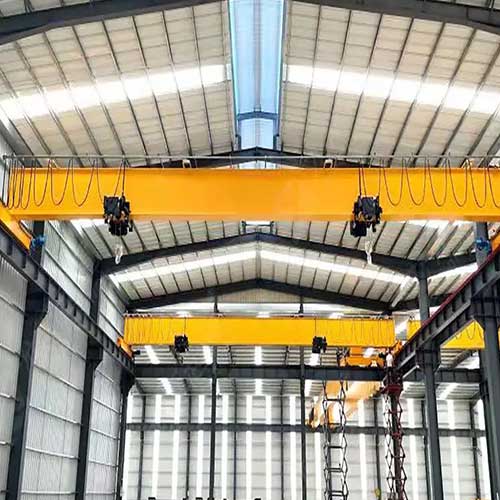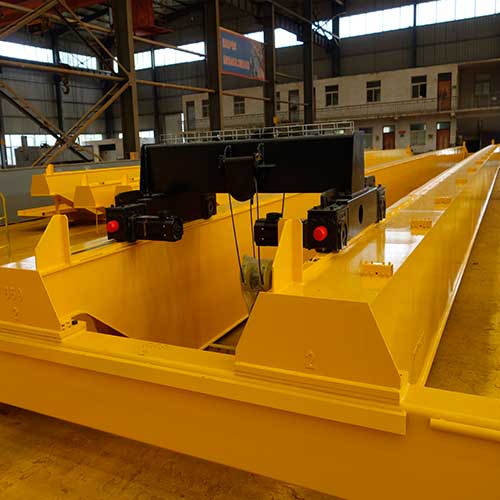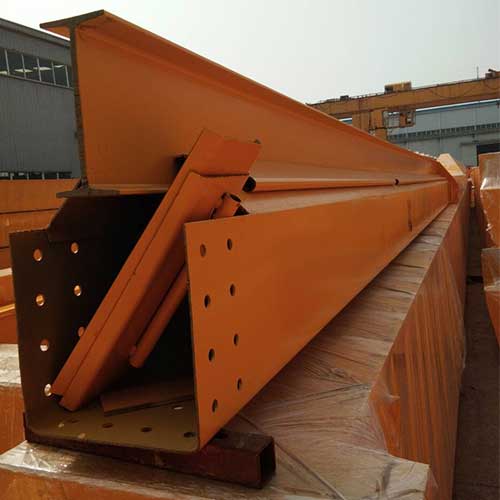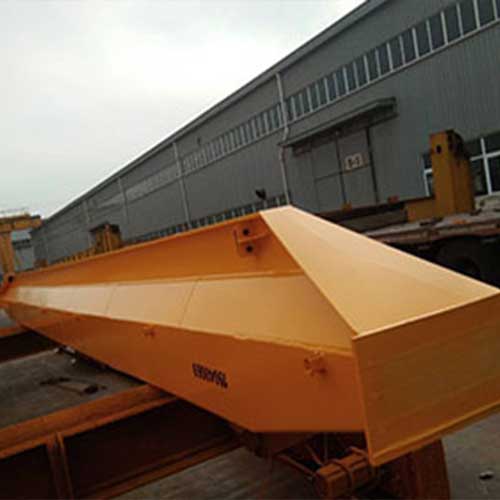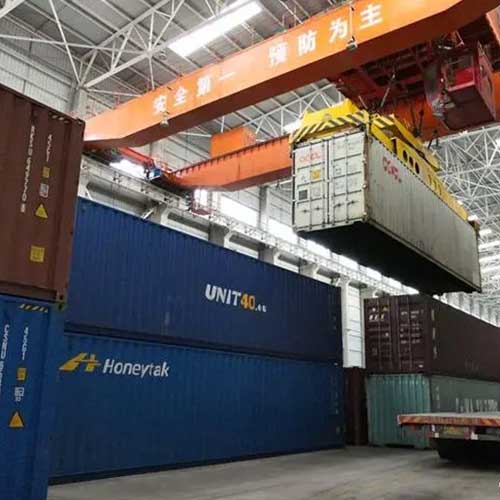5 Ton 10 Ton 20 Ton Top Running Single Girder Cranes:Types & Uses
Top running single girder cranes overview for you to select cost-effective top running crane & crane system. Tailored top running crane 1 - 20 ton for sale.
Category: Top Running Crane
Your Trusted Top Running Crane Manufacturer & Supplier
5 Ton 10 Ton 20 Ton Top Running Single Girder Cranes:Types & Uses
Top running single girder cranes overview for you to select costeffective top running crane & crane system. Tailored top running crane 1 20 ton for sale.
Overview of Top Running Single Girder Cranes
Top Running Single Girder Cranes When it comes to optimizing material handling processes, the right choice of crane can make all the difference. Enter the world of Top Running Single Girder Cranes – a dynamic solution designed to revolutionize the way industries move loads and streamline operations.
Definition and Basic Structure
At its core, a Top Running Single Girder Crane is a workhorse of efficiency, consisting of a single girder that is positioned on top of runway beams. This ingenious design maximizes usable space while ensuring reliable lifting and movement capabilities. The single girder, the horizontal beam spanning the width of the crane, carries the load with precision and finesse.
Advantages of Top Running Design
The strategic positioning of the single girder atop the runway beams comes with a multitude of advantages that drive the popularity of this crane type. Firstly, its top running configuration means the crane takes up minimal headroom, allowing for more efficient use of available space. This is a crucial benefit, particularly in environments where vertical space is limited.
Moreover, the top running design minimizes interference with floor operations, enabling smoother workflow and reducing potential bottlenecks. The elevated girder also provides better visibility for operators, ensuring safe and precise load handling.
Comparison with Other Crane Types
Top Running Single Girder Cranes distinguish themselves from their counterparts through their efficiency and versatility. In contrast to the more complex double girder design, the single girder construction strikes a balance between load capacity and structural simplicity. While double girder cranes are favored for extremely heavy loads, the top running single girder crane meets the needs of various industries with moderate load requirements.
Additionally, the top running single girder crane offers a costeffective solution without compromising on performance. This makes it an attractive option for businesses looking to optimize their material handling capabilities while maintaining budget constraints.
In the upcoming sections of our guide, we'll delve deeper into the different types of top running single girder cranes, their features, benefits, applications, and more. Whether you're seeking efficiency, space optimization, or precision handling, the world of top running single girder cranes has something to offer for everyone.
Stay tuned as we explore the vast possibilities that these cranes unlock in industries ranging from manufacturing and logistics to construction and beyond. Let's elevate your material handling efficiency together!
Exploring Types of Top Running Single Girder Cranes: Tailoring Efficiency to Your Needs
Welcome back to our journey through the world of top running single girder cranes. In this segment, we're delving into the diverse array of crane types that fall under this category. Each type brings a unique blend of features, benefits, and capabilities, allowing you to find the perfect fit for your material handling requirements.

Standard Top Running Single Girder Overhead Crane: Efficient Versatility
The Standard Single Girder Overhead Crane stands as a timeless solution for various material handling needs. With its single girder perched atop sturdy runway beams, this crane offers a balance of load capacity and streamlined design. Its efficiency shines in tasks where lifting, transferring, and positioning materials are paramount. From manufacturing floors to warehouses, the Standard Single Girder Overhead Crane stands as a dependable workhorse.

Top Running Single Girder Semi Gantry Crane : Optimized Space and Flexibility
A hybrid marvel, the Semi Gantry Crane with Single Girder marries the benefits of a single girder crane with the mobility of a gantry crane. With one end supported by a gantry leg and the other mounted on a runway, this crane optimizes space while maintaining outdoor flexibility. It's a perfect choice when uneven terrain or limited space necessitates innovative solutions.
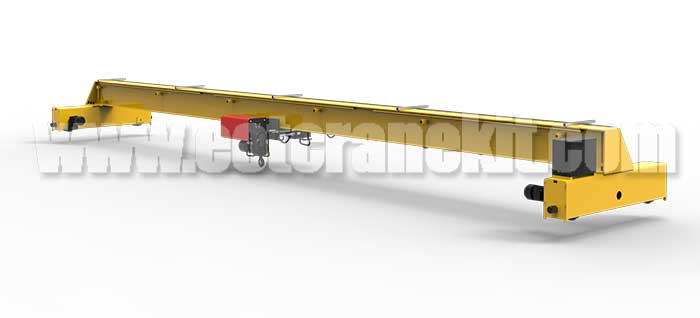
European Style Top Running Single Girder Crane: Precision and Compliance
Crafted to European engineering standards, the European Style Single Girder Crane epitomizes precision and adherence to strict regulations. With advanced safety features and meticulous engineering, it's a top choice for industries demanding compliance and quality. This crane excels in environments where safety and precision are paramount, such as the automotive and pharmaceutical sectors.

Chinese Style Single Girder Crane: Practicality and Adaptability
Embodying Chinese engineering practices, the Chinese Style Single Girder Crane presents a practical and adaptable solution. Known for its costeffectiveness and customization options, this crane type caters to diverse industry needs. Its design resonates with sectors seeking tailored solutions without compromising efficiency.
Top running single girder overhead cranes
Due to the top running single girder cranes can be classified into different groups and types based on the different standards. In the follwing main types of top running single beam cranes are presented for your reference. These classifications can help in selecting the appropriate top running single girder crane based on specific requirements, load capacities, operating conditions, and industry standards. It's important to consult with crane manufacturers or professionals to ensure that the chosen crane meets the intended application's needs.
A top running single girder crane is a type of industrial crane commonly used in factories, warehouses, and other material handling environments. It consists of a single girder beam that runs along the top of the crane structure, supported by end trucks on either side. The girder carries the hoist and trolley assembly, which is responsible for lifting and moving loads horizontally along the length of the crane.
Top Running Single Girder Overhead Crane 1Ton, 5 Ton, 10 Ton, 20 Ton :
- Features: Single girder design mounted on top of runway beams, suitable for indoor spaces with limited headroom.
- Benefits: Efficient vertical lifting and horizontal movement, optimal use of available space, versatility for various load capacities.
- Typical Applications: General material handling, production lines, warehouses, workshops.
- Industrial Sectors: Manufacturing, logistics, automotive, textiles.
Key features of a top running single girder crane include:
- 1. Single Girder: Unlike double girder cranes that have two parallel beams, a single girder crane has only one girder running across the width of the crane bay. This design makes the crane lighter and more costeffective, making it suitable for light to moderate load capacities.
- 2. Top Running Configuration: The crane's girder is positioned on top of the runway beams, allowing it to maximize the available vertical space in the facility. This is particularly useful in spaces where headroom is limited.
- 3. End Trucks: These are the structures located at the ends of the girder. They include wheels that ride on the runway beams, allowing the crane to move along the length of the crane bay. The end trucks also house the motor and drive mechanism for the horizontal movement of the crane.
- 4. Hoist and Trolley: The hoist is the lifting mechanism responsible for raising and lowering the loads. It is attached to a trolley that runs along the length of the girder, allowing the load to be positioned anywhere within the crane's coverage area.
- 5. Control System: Top running single girder cranes are typically equipped with a control system that enables operators to maneuver the crane, control the lifting and lowering of loads, and ensure precise positioning.
These cranes are suitable for a variety of applications, such as assembly lines, maintenance tasks, material handling, and more. The single girder design is best suited for lighter loads and shorter spans. For heavier loads and longer spans, a double girder crane might be a more appropriate choice due to its increased loadbearing capacity.
When considering the use of a top running single girder crane, factors such as load capacity, span length, facility layout, and usage frequency should all be taken into account to ensure that the crane meets the specific requirements of the operation.

European Style Single Girder Crane: Precision and Compliance
Features:
- Engineered to European standards.
- Advanced safety systems and compliance measures.
- Precision engineering for critical operations.
Benefits:
- Adherence to strict safety and quality regulations.
- Ideal for sectors requiring meticulous compliance.
- Enhanced efficiency and precision in material handling.
Applications:
- Automotive manufacturing.
- Aerospace industry.
- Pharmaceuticals and critical operations.

Chinese Style Top Running Single Girder Double Hoist Crane: Customized Solutions for Diverse Needs
Features:
- Reflects Chinese engineering practices and preferences.
- Costeffective design without compromising performance.
- Tailored solutions for specific operational requirements.
Benefits:
- Adaptable to various industries and applications.
- Budgetfriendly solutions for material handling challenges.
- Flexibility in design and customization options.
Applications:
- Industries with specific needs and cost considerations.
- Diverse manufacturing and material handling sectors.
Top Running Single girder gantry cranes
Top running single girder gantry cranes are a specific type of crane that combines the benefits of a top running single girder design with the mobility of a gantry crane. These cranes have a single girder structure positioned on top of two legs that run on rails or tracks, allowing for movement along the ground. They are commonly used in outdoor applications, construction sites, shipyards, and other areas where the terrain might be uneven or where there is a need for greater mobility.

Top Running Single Girder Semi Gantry Crane:
- Features: Single girder design on top of gantry legs, offering outdoor capabilities and flexible positioning.
- Benefits: Suitable for outdoor applications, provides clear workspace beneath, versatile movement.
- Typical Applications: Shipyards, construction sites, outdoor storage yards, material yards.
- Industrial Sectors: Shipbuilding, construction, steel yards.
The main types of top running single girder gantry cranes include:
These top running single girder gantry cranes offer the advantages of both the top running design (which minimizes headroom and interference with floor operations) and the mobility of gantry cranes (which can move along rails to cover a larger area). They are suitable for various industries and applications that require efficient material handling in outdoor or spacerestricted environments.

Full Gantry Crane with Single Girder:
This type of crane has two legs that run on rails along the ground, providing stability and mobility. The single girder is positioned on top of the legs and carries the load. Full gantry cranes are commonly used in outdoor applications, construction sites, and shipyards where heavy materials need to be lifted and moved across a wide area.
- Full Gantry Crane with Single Girder: Optimized Heavy Load Handling
- Features: Strong structure with ground rails. Single girder design.
- Capable of handling heavy loads. Outdoor mobility for wide coverage.
- Benefits: Efficient use of outdoor and indoor spaces. Versatile for various areas.
- Typical Applications: Construction sites with heavy materials. Shipyards for loading/unloading ship components. Outdoor production areas with large materials.
- Industrial Sectors: Construction industry for buildings and infrastructure. Shipbuilding and repair tasks. Heavy manufacturing in steel mills and fabrication. Prefabrication yards for efficient material movement.

Top Running Single Girder Semi Gantry Crane:
Similar to the full gantry crane, the semi gantry crane has one end supported by a gantry leg while the other end runs on a runway or rails attached to a building structure. This configuration allows for more flexibility in terms of space utilization and is ideal for areas with limited space on one side. Semi gantry cranes are often used in outdoor environments with uneven terrain or in workshops with constrained space.
- Features: Single girder on one side, gantry leg on the other, combines advantages of gantry and overhead cranes.
- Benefits: Space optimization, versatility for different areas, efficient use of outdoor and indoor spaces.
- Typical Applications: Uneven terrain, workshops with limited headroom on one side, outdoor production areas.
- Industrial Sectors: Manufacturing, construction, fabrication.
These types of top running single girder cranes are designed to meet different operational requirements and cater to various industries. Understanding their features and benefits helps in selecting the most suitable crane for specific applications within different industrial sectors.
Classification by Load Capacity:
You are correct, and I apologize for any confusion in my previous responses. Single girder cranes are generally designed for lighter to moderate load capacities, typically up to 20 tons or slightly more. For heavier loads beyond this capacity, double girder cranes are often preferred due to their increased stability and lifting capabilities.

Light Duty I Beam Top Running Single Girder Crane: Versatile Handling for Small Loads
Features:
- Designed for loads up to 5 tons.
- Lightweight structure for efficient handling.
- Ideal for tasks requiring precision and maneuverability.
Benefits:
- Exceptional versatility for diverse material handling needs.
- Spaceefficient design for compact workspaces.
- Lower energy consumption and reduced maintenance.
Applications:
- Small workshops.
- Assembly lines.
- Maintenance tasks.

Standard Duty Box Girder Top Running Single Girder Crane: Meeting the Middle Ground
Features:
- Capacity range from 5 to 20 tons (approx.).
- Suitable for moderate load handling.
- Versatile for various material movement tasks.
Benefits:
- Balances load capacity and structural simplicity.
- Enhanced efficiency in manufacturing and warehousing.
- Smooth operations with moderate load requirements.
Applications:
- Manufacturing facilities.
- Warehouses and distribution centers.
- General material movement.
Application Based Classification of Top Running Single Girder Cranes :
This classification focuses on the specific tasks and industries that top running single girder cranes are designed to serve. Different applications require cranes with tailored features to meet the demands of the work environment. Here are the two main categories:

General Material Handling Crane:
- General material handling cranes are versatile machines designed to address a wide range of routine material movement tasks. These cranes are commonly found in various sectors that involve the handling, loading, and unloading of materials. Some key features and applications include:
- Manufacturing: General material handling cranes are frequently used in manufacturing facilities to transport raw materials, components, and finished products along assembly lines.
- Warehousing: These cranes play a crucial role in warehouses by moving goods to and from storage areas, helping optimize storage space and streamline inventory management.
- Logistics: Cranes in logistics settings assist in loading and unloading goods from trucks and containers, facilitating the smooth flow of materials in distribution centers and shipping yards.
- Retail: In retail environments, these cranes aid in stocking shelves and moving merchandise within stores, making it easier for employees to manage inventory.

Process cranes are designed with precision and specialized features to cater to specific tasks within heavy industries. These industries demand careful control and unique handling capabilities. Some key features and applications include:
- Steel Mills: Process cranes in steel mills handle extremely heavy loads, often in hightemperature environments. They're used for tasks like moving molten metal, transporting large coils, and assisting in steel production processes.
- Paper Mills: Paper production involves handling large rolls of paper and heavy machinery. Process cranes are used to transport paper rolls, manage pulp, and assist in various stages of the papermaking process.
- Heavy Manufacturing: Industries such as shipbuilding, automotive manufacturing, and aerospace require process cranes for precise lifting and positioning of massive components during assembly.
- Power Plants: In power generation facilities, process cranes are essential for maintaining and repairing heavy equipment, such as turbines and generators.
These classifications help in selecting the appropriate top running single girder crane based on the specific needs of an application. While general material handling cranes offer versatility for routine tasks across different sectors, process cranes are engineered for the demands of heavy industries where precision, reliability, and specialized features are paramount.
Operating Environment Classification for Top Running Single Girder Cranes:
This classification categorizes top running single girder cranes based on the environments in which they are intended to operate. The choice of indoor or outdoor crane depends on factors such as weather conditions, facility layout, and the nature of the tasks. Here are the two main categories:

Top Running Single Girder Indoor Crane:
Indoor cranes are designed to function optimally within enclosed indoor spaces, such as factories, warehouses, workshops, and manufacturing facilities. Key features and applications include:
- Space Optimization: Indoor cranes are tailored to efficiently use available vertical space without external weather considerations.
- Climate Control: Since they operate indoors, these cranes do not face exposure to weather extremes, allowing for more consistent and controlled working conditions.
- Material Movement: They excel in moving materials and products within confined spaces, making them ideal for assembly lines, production areas, and indoor storage.

Top Running Single Girder Bridge Crane Outdoor Crane:
Outdoor cranes are engineered to endure the challenges of outdoor environments, where they might be subjected to varying weather conditions, dust, moisture, and temperature fluctuations. Key features and applications include:
- Weather Resistance: Outdoor cranes are designed to withstand elements such as rain, wind, and temperature extremes, ensuring reliable performance in adverse conditions.
- Construction Sites: Outdoor cranes are often used in construction yards to lift heavy building materials, equipment, and components during construction projects.
- Shipping Ports: These cranes play a crucial role in loading and unloading cargo from ships and containers in ports.
- Yards and Depots: Outdoor cranes are utilized in storage yards and depots for the movement and positioning of materials such as lumber, steel, and bulk commodities.
The choice between indoor and outdoor cranes depends on the specific requirements of the application. Indoor cranes provide controlled environments that are wellsuited for tasks that require precision and protection from weather. Outdoor cranes, on the other hand, are built to withstand outdoor challenges and are essential for industries such as construction, shipping, and heavy logistics.
Control Method Classification for Top Running Single Girder Cranes:
This classification focuses on the methods used to control the movement and operations of top running single girder cranes. The choice of control method impacts the ease of operation, precision, and overall efficiency of the crane. Here are the two main control methods:

Pendant Controlled Top Running Single Girder Crane:
Pendant controlled cranes are operated using a pendant control, which is a handheld device connected to the crane via a cable. The operator holds the pendant control and uses buttons or switches to initiate crane movements and control functions. Key features and applications include:
- Direct Interaction: The pendant control allows the operator to have direct physical control over the crane's movements, making it suitable for tasks that require handson precision.
- Proximity to Load: Operators can position themselves closer to the load and observe the movement more closely, which can be advantageous for tasks that demand accuracy.

Radio Remote Controlled Top Running Single Girder Crane:
Radio remote controlled cranes are operated using a wireless remote control device. The operator can control the crane's movements and functions from a distance without the need for physical cables. Key features and applications include:
- Flexibility: The wireless remote allows operators to control the crane from a distance, providing greater flexibility and visibility for tasks that require a broader view of the workspace.
- Safety: Operators can maintain a safe distance from potentially hazardous areas or loads while operating the crane, enhancing overall safety during material handling.
- Reduced Clutter: The absence of cables and pendant cords reduces clutter around the crane, improving workspace safety and organization.
Both control methods have their advantages and are chosen based on the specific needs of the application. Pendant controlled cranes offer direct physical interaction and precision, while radio remote controlled cranes provide flexibility, safety, and reduced clutter in the workspace. The selection of the control method depends on factors such as the complexity of tasks, operator preferences, and safety considerations.
Hoist Type Classification for Top Running Single Girder Cranes:
This classification focuses on the type of hoist mechanism employed in top running single girder cranes. The hoist is responsible for lifting and lowering loads, and the choice of hoist type can affect lifting efficiency, load capacity, and control. Here are the two main hoist types:

Wire Rope Hoist Top Running Single Girder Overhead Crane:
- Wire rope hoist cranes are equipped with a hoisting mechanism that utilizes a steel wire rope to lift and lower loads. This type of hoist offers several advantages for various applications:
- Efficient Lifting: Wire rope hoists provide efficient lifting due to the reduced weight of the wire rope itself, allowing for higher lifting speeds and smoother operation.
- Higher Load Capacity: Wire rope hoists can handle larger loads compared to their chain counterparts, making them suitable for heavyduty lifting applications.
- Durability: The steel wire rope is designed to withstand heavy loads and resist wear and tear, contributing to the hoist's longterm durability.

Electric Chain Hoist Top Running Sinlge Beam Overhead Crane:
Chain hoist cranes feature a hoisting mechanism that uses a chain to lift and lower loads. Chain hoists offer their own set of benefits for specific material handling needs:
- Precise Control: Chain hoists allow for more precise load positioning due to their incremental lifting capabilities, making them suitable for applications that require accurate load placement.
- Compact Design: Chain hoists have a more compact design compared to wire rope hoists, which can be advantageous in environments with limited vertical clearance.
- Suitable for Vertical Lifting: Chain hoists are often preferred for tasks that involve vertical lifting or tasks where precise control is essential.
The choice between wire rope and chain hoist cranes depends on the specific requirements of the application. Wire rope hoists are favored for their efficiency and high load capacity, making them suitable for heavy lifting tasks. On the other hand, chain hoists excel in applications that require precise control and where space considerations are important.
Special Features Classification for Top Running Single Girder Cranes:
This classification focuses on the unique design features of top running single girder cranes that cater to specific spatial constraints and material handling requirements. Different types of special features enhance the versatility and effectiveness of these cranes in various scenarios. Here are the three main special features:

Low Headroom Top Running Single Girder Crane:
Low headroom cranes are engineered to operate efficiently in spaces with limited vertical clearance. These cranes are designed to maximize the available space without compromising on lifting capacity or safety. Key features and applications include:
- Vertical Clearance: Low headroom cranes are designed with compact dimensions to minimize the distance between the crane's girder and the ceiling, making them suitable for facilities with restricted headroom.
- Efficient Use of Space: These cranes make optimal use of vertical space, allowing for efficient material handling even in areas with low ceilings.
- Suitable for Confined Areas: Low headroom cranes are commonly used in areas where traditional cranes may not fit, such as retrofitting existing structures or working within basements.

Top Running Single Monorail Crane:
Monorail cranes operate on a single rail, offering linear movement for material handling tasks that involve moving loads along a fixed path. Key features and applications include:
- Linear Movement: Monorail cranes provide pointtopoint linear movement, making them suitable for tasks such as assembly lines, painting processes, and sequential material handling.
- Compact Design: Due to their single rail design, monorail cranes are spaceefficient and can be installed in narrow or confined spaces.
- Customization: Monorail systems can be configured with various features such as curves, switches, and turntables to adapt to specific workflow needs.
These special features cater to specific spatial and material handling requirements, enhancing the adaptability and functionality of top running single girder cranes in various settings. The choice of crane type with special features depends on factors such as available space, workflow, and the unique challenges of the operating environment.

Top Running Single Girder Explosion Proof Crane:
Explosionproof cranes are specifically designed to operate safely in environments where there is a risk of explosive gases, vapors, or dust. These cranes are constructed with components and materials that prevent the generation of sparks and mitigate the risk of ignition in potentially hazardous areas. Key features and applications include:
- Safe Operation: Explosionproof cranes are engineered to prevent sparks, electrical discharges, and other potential sources of ignition, reducing the risk of explosions in volatile environments.
- Certification: These cranes are usually certified by relevant safety organizations to ensure compliance with strict safety standards for hazardous locations.
- Industries: Explosionproof cranes are commonly used in industries such as oil and gas, chemical processing, pharmaceuticals, and other environments where flammable materials are present.

Top Running Single Girder Metallurgical Hoist Crane:
Metallurgical hoist cranes are designed for the unique demands of metallurgical processes, where the handling of molten metal and heavy materials is required. These cranes are equipped with features that allow them to operate effectively in extreme temperatures and challenging conditions. Key features and applications include:
- HighTemperature Resistance: Metallurgical cranes are designed to withstand high temperatures and extreme heat, often encountered in industries like steel mills and foundries.
- Specialized Materials: These cranes are constructed using materials that can withstand the corrosive effects of molten metal, chemicals, and other harsh substances.
- Custom Attachments: Metallurgical cranes can be fitted with specialized attachments like ladles, tongs, and hooks designed to handle molten metal and heavy metal products.
- Precise Control: These cranes require precise control to handle delicate movements when dealing with molten metal, ensuring safe and efficient material handling.
Both explosionproof cranes and metallurgical hoist cranes are examples of specialized top running single girder cranes that address the unique challenges of specific industries and operating conditions. Explosionproof cranes prioritize safety in potentially explosive environments, while metallurgical hoist cranes are built to handle extreme temperatures and the demands of metallurgical processes. These specialized cranes play a critical role in ensuring safe and efficient operations in their respective industries.
Industry Based Classification for Top Running Single Girder Cranes:
This classification categorizes top running single girder cranes based on the specific industries they are tailored to serve. Different industries have distinct material handling requirements, and these cranes are designed with features that cater to those needs. Here are a few examples:
- Automotive Crane: Automotive cranes are customized to efficiently handle various components and parts within automotive manufacturing plants. Key features and applications include: Assembly Line Support: These cranes aid in the assembly of vehicles by transporting parts and components to different stages of the assembly line. Component Handling: Automotive cranes are used to lift and position components such as engines, transmissions, and chassis during manufacturing processes.
- Aerospace Crane: Aerospace cranes are precisionengineered to delicately manage the handling of components within the aerospace industry. Key features and applications include: Delicate Handling: Aerospace components are often sensitive and require careful positioning. These cranes ensure precise movement to avoid damage. Heavy Components: Aerospace cranes are equipped to handle large and heavy components such as aircraft engines and fuselage sections.
- Foundry Crane: Foundry cranes are designed to thrive in the demanding and harsh conditions of foundries, where extreme temperatures and heavy loads are common. Key features and applications include: HighTemperature Resistance: Foundry cranes are engineered to withstand the heat generated by molten metal, making them suitable for lifting ladles and molds. Durable Materials: These cranes are constructed with materials that can resist the corrosive effects of molten metal and foundry environments.
- Glass Industry Crane: Customized for the delicate handling of glass sheets and panels in glass manufacturing plants and processing facilities. These cranes ensure precise movement and positioning to prevent damage to the fragile glass materials.
- Textile Printing Crane: Designed to assist in the textile printing process by transporting and positioning fabric rolls, ensuring accurate alignment during the printing process in textile printing facilities.
- Chemical Mixing Crane: Engineered for the safe movement of containers and ingredients within chemical mixing and blending operations, supporting the creation of chemical compounds and solutions.
- Warehouse Logistics Crane: Used in large warehouses for efficient material handling and inventory management, facilitating the movement of goods and products within storage and distribution centers.
- Pharmaceutical Research Crane: Catering to research laboratories, these cranes aid in transporting sensitive laboratory equipment, chemicals, and materials required for pharmaceutical research and development.
- Automated Assembly Crane: Integrated into automated assembly lines, these cranes contribute to the seamless assembly of products by precisely positioning components during the manufacturing process.
- HighRise Construction Crane: Tower cranes used in the construction of skyscrapers and tall buildings, capable of lifting heavy construction materials and equipment to great heights.
- Nuclear Industry Crane: Specialized cranes for the nuclear sector, designed to handle nuclear materials, components, and equipment while adhering to strict safety and regulatory standards.
- Container Port Crane: Largescale cranes used in container terminals and ports for loading and unloading cargo containers from ships, trucks, and trains, facilitating global trade and logistics.
- Cold Storage Crane: Adapted for cold storage warehouses and facilities, these cranes handle products in refrigerated environments, ensuring efficient movement and storage of temperaturesensitive goods.
- Mining Exploration Crane: Utilized in mining exploration and drilling operations, these cranes assist in moving drilling equipment and extracting core samples from geological formations.
- Waterfront Crane: Found in coastal areas, waterfront cranes handle various tasks such as ship unloading, cargo transfer, and port maintenance, supporting maritime operations.
- Power Transmission Crane: Designed for power transmission and utility industries, these cranes assist in installing and maintaining power lines, transformers, and other electrical infrastructure.
These additional examples showcase the diverse range of industries and specific applications where specialized cranes play a pivotal role. The customization of crane features and functionalities ensures that each crane type meets the unique challenges and demands of its respective industry, contributing to enhanced operational efficiency and safety.
Addressing User Concerns: Ensuring Seamless Crane Operations
In this segment, we delve into the vital aspect of user concerns surrounding top running single girder cranes. From safety measures to customization, we address the questions that arise when considering these lifting solutions for your operations.
Safety Measures and Compliance: Your Peace of Mind
Importance of Safety Measures:
- Safety is paramount in any industrial setting.
- Adherence to safety regulations ensures a secure working environment.
- Top running single girder cranes come equipped with advanced safety features.
How These Cranes Ensure Safety:
- Overload protection to prevent excessive strain on the crane.
- Limit switches to control crane travel and prevent collisions.
- Emergency stop buttons for immediate shutdown in case of any hazard.
Ensuring Compliance:
- Compliance with industry standards and regulations.
- European style cranes designed to adhere to stringent European norms.
- Prioritizing safety training for operators and maintenance personnel.
Choosing the Right Capacity and Configuration: A Perfect Fit
Determining the Right Capacity:
- Analyzing the heaviest load to be lifted.
- Considering potential future load increases.
- Selecting a crane with a capacity that meets your needs without overburdening.
Configurations to Match Your Space:
- Optimal selection between overhead, gantry, and semi gantry configurations.
- Top running cranes ideal for facilities with limited headroom.
- Gantry options for outdoor applications or uneven terrains.
Maintenance and Service: Ensuring Longevity
Maintenance as a Priority:
- Regular maintenance extends the crane's operational life.
- Routine checks for wear and tear, lubrication, and component inspection.
- Maintenance schedules tailored to your operational demands.
Importance of Professional Service:
- Partnering with crane manufacturers for maintenance and repairs.
- Expert technicians trained in crane mechanics and safety standards.
- Timely response to minimize downtime and maintain efficiency.
Customization for Specific Needs: Tailored Solutions
Understanding Your Needs:
- Every industry has unique operational demands.
- Customization ensures the crane aligns with your specific tasks.
Tailoring Solutions:
- Modifications for specialized load attachments.
- Adjustments for specific working conditions and environments.
- Custom control systems to suit your workflow.
In the final sections of our guide, we'll be addressing frequently asked questions about top running single girder cranes. As you continue to explore the possibilities and benefits of these cranes, we're here to provide you with the knowledge and insights needed to make informed decisions for your material handling needs. Stay tuned for the culmination of our comprehensive guide!
Frequently Asked Questions About Top Running Single Girder Cranes: Clarifying Your Queries
As we approach the conclusion of our guide, we address the frequently asked questions that often arise when considering top running single girder cranes. These questions and their answers provide valuable insights to help you make wellinformed decisions for your material handling needs.
1. What is the Load Capacity Range of These Cranes?
Top running single girder cranes are designed to handle a range of load capacities, typically from 1 ton up to around 20 tons. It's essential to choose a crane with a capacity that matches your heaviest load while considering potential future requirements.
2. Can These Cranes Be Used Outdoors?
Yes, top running single girder cranes can be used outdoors. The semi gantry crane with single girder configuration, for example, is specifically designed to provide outdoor flexibility. Outdoor cranes are equipped to withstand varying weather conditions and are an excellent solution for construction sites, shipyards, and other outdoor applications.
3. What Safety Features Are Integrated?
Top running single girder cranes are equipped with advanced safety features to ensure secure operations. These features often include overload protection to prevent excessive strain on the crane, limit switches that control crane travel and prevent collisions, emergency stop buttons for immediate shutdown, and safety interlocks to prevent unauthorized usage.
4. How Do I Choose Between European and Chinese Styles?
Choosing between European and Chinese styles depends on your specific needs and preferences. European style cranes are known for their precision engineering, adherence to strict safety standards, and compliance with European norms. Chinese style cranes offer costeffective solutions and the flexibility of customization. Consider factors such as safety regulations, operational requirements, and budget constraints when making your choice.
As you conclude your journey through our comprehensive guide on top running single girder cranes, we hope these answers have provided clarity and insight. Remember that each crane type has its unique advantages, applications, and considerations. Should you have further questions or require personalized assistance, our team of experts is ready to support you in finding the perfect lifting solution for your operations.
Main Projects
Related Products

Supplied three grab bucket crane kits to Indonesia, enhancing garbage handling efficiency with high load capacity and reliable performance.
Free consultation to Confirm Parameters & Specifications and Get
Latest Crane Price & Crane Rate.
- Types of overhead cranes : _______?
- Optional: Overhead travelling crane, goliath gantry crane,Slewing jib crane, Single girder or double girder crane,small portable crane or kbk crane, etc.
- Capacity of overhead crane: _______?
- Optional: 0.25ton, 0.5 ton, 1 ton, 2 ton, 3ton, 5 ton, 10 ton,15ton, 20ton, 25 ton, 30ton,35ton, up to 550ton, etc.
- Crane span & lifting height : _______?
- Crane travelling length : _____?
- Control of overhead crane:_______?
- Optional: pendant/ remote/cabin control
- Voltage supply of overhead crane:_____?
- Eg,: 380V50/60HZ,3Phase or others,etc.
- Application/usage of crane:_______?
- Eg,: Steel mill, ,injection mold, cement,stone, concrete,granite, general manufacturing, etc.
Just leave a message via the contact form and our hoist and crane engineer will contact you with in 24working hours.
Get In Touch
